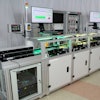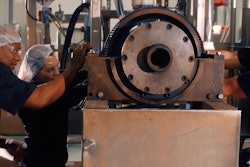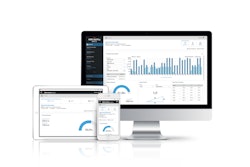Condition monitoring technologies enable early detection of operating abnormalities in rotating equipment with the objective to make fixes before problems escalate. While periodic surveillance of machinery health will usually be sufficient for relatively non-critical assets, machines considered “too critical to fail” represent candidates for more frequent and/or continuous monitoring.
When a machine fails unexpectedly, the unplanned downtime, unanticipated deployment of maintenance staff, and resulting lost productivity will disrupt any industrial operation. The toolbox of condition monitoring technologies for advance warning includes a range of options from basic handheld or stand-alone data collectors to more sophisticated, connected, and networked systems.
Some devices and instruments focus on assessing the more significant operating parameters, such as vibration, while highly engineered systems at the other end of the spectrum can be configured to monitor and diagnose many more. Their capabilities expand with integration into computerized maintenance management systems, the use of specialized software programs, and application modules and accessories targeting specific types of analysis.
For especially critical assets, continuous monitoring serves as a practical and, in many situations, indispensable lifeline. On-line systems deliver up-to-the-minute information – collecting data 24/7 or over a predetermined data-collection frequency via permanently mounted sensors and then transmitting that data (using either hardwired or wireless systems) to a host computer running relevant software packages.
Abnormalities in machine operation and performance will be detected based on measurements of various physical operating parameters, including vibration, temperature, and others. The mounted sensors and compatible software ultimately can uncover issues and allow for timely analysis and pre-emptive remedial fixes before it’s too late.
Hardwired On-Line Systems
On-line monitoring solutions using hardwired sensors illustrate how far the technology has evolved, both in form and function. A variety of systems have been engineered for use in all types of industrial plants, even those characterized by extremely tough and challenging operating environments. Systems have further diversified to provide monitoring functions applicable to specific industries.
As an example of a complete hardwired system for early fault detection and prevention, one of the more robust and programmable units can run on an existing LAN or WAN and can network with computers, printers, and servers, or over the internet. A substantial internal memory (typically up to 4GB) can store a year’s worth of machine data and numerous event captures to promote tracking, trending, and analysis over time.
Units in the marketplace have been engineered to incorporate 8, 16, or 32 analog signal inputs and multiple digital inputs configurable for use with standard industrial sensors to collect data on vibration, acceleration, velocity, displacement, and temperature, among other parameters including tachometers. Individual warning and alarm levels controlled by machine speed or load can be set for each measurement point.
As safeguards, a built-in auto-diagnosis capability checks all sensors, cabling, and electronics for any faults, signal interruption, shorts, or power failure and then automatically alerts when problems are found.
Such systems can further connect with cloud services for storing and sharing data and for accessing expert reporting and recommendations from a remote diagnostic services location. The capability to connect with mobile devices and laptops allows for user-friendly configuration and real-time display of machine condition data.
For such hardwired units, size almost always matters. Purposely compact units – no bigger than a paperback novel – fill an outsized need by fitting easily into smaller spaces and opening opportunities to save cost and make installation easy by utilizing existing instrumentation cabinets. The smaller footprint also more readily accommodates applications where monitoring instruments may need to be located as closely as possible to the monitored machinery.
Untethered Wireless On-Line Systems
For some machine surveillance jobs, especially when only required temporarily, setting up and implementing a hardwired system may be impractical. Perhaps fixed cabling may not be logistically possible, a permanent system cannot be justified on certain semi-critical or balance-of-plant machines, or costs associated with cabling and installation may get in the way. Fully untethered, wireless systems can overcome such issues.
In addition, the potential of WiFi-enabled monitoring systems can be expanded by facilitating monitoring applications that in the past may have been difficult or impossible, such as temporary installations positioned for troubleshooting or applications involving monitoring from remote locations.
Exemplifying one of the latest technologies, a compact, self-contained, and battery-powered wireless on-line system offers a path forward in a plant’s ability to realize machine reliability objectives. The 8-channel, field-mounted monitoring device can be employed to broaden 24/7 monitoring coverage, monitor “bad actors,” troubleshoot, supplement walk-around routes, enable remote monitoring, and/or provide “end of life” tracking of failing components, such as bearings. Such units can easily be relocated whenever and wherever needed.
Here’s what a system can deliver when equipped with four channels to monitor vibration, four process inputs, and one tachometer input. Using standard industrial constant current powered sensors, the system collects acceleration, velocity, displacement, temperature, and bearing condition and automatically uploads and stores the data for viewing, alarm evaluation, and analysis using proprietary software.
A system usually will be programmed to “wake up” and take measurements based on a fixed time interval, or it can be externally activated on demand by a programmable logic controller. Either way, wireless technology expands condition monitoring capabilities where hardwired systems cannot and widens the scope of proactive machine monitoring throughout a plant.
Whether hardwired or wireless, viable machine condition monitoring systems introduce ideal technologies to perform appropriate inspections, maintenance activities, and fixes at the right time when and where needed, regardless of the calendar. As a result, plant operations can extend maintenance intervals, consolidate maintenance initiatives, and reduce risks of unplanned downtime and the lost productivity that follows.
One more observation: Enlisting expert support can tip the scales even more favorably toward optimized outcomes. Partnering with an established services provider with experience in the many interrelated aspects of condition monitoring is always a plus. Engaging the appropriate engineering resources and analysis capabilities will help to realize any plant’s central mission of keeping critical machinery up and running as intended.
Greg Ziegler is Strategic Program Manager at SKF USA Inc. He has more than 30 years of experience with Machinery Protection systems, On-Line Condition Monitoring systems, and sensor technologies for industrial applications. Prior to his current position, he managed the company’s Condition Monitoring product service business, leading a team of engineers for system installations, maintenance, training, and mentoring customers.























